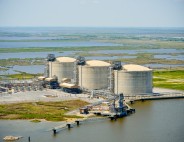
The Oil and Gas Boom Continues
05 Aug, 2014
Private sector investments fueling the industry’s future.
By Mark Kleszczewski
Thanks in part to widening adoption of new discovery and extraction technologies, the domestic oil and gas sector continues to boom, resulting in lower energy prices and a dramatic reduction in dependence on foreign oil that’s brought the country closer to energy self-sufficiency than at any time in the last three decades.
The sector has also spurred significant job creation, with direct employment in the oil and gas industry rising 40 percent from 2007 through 2013, as compared to a decline of about three percent in the overall U.S. economy, noted Investor’s Business Daily in February.
For industry, tapping into newfound reserves is not only benefiting producers of steel, plastics, glass, paper and cement, but manufacturers of everyday consumer products. In a recent study, PricewaterhouseCoopers calculates that U.S. manufacturers could be saving more than $11 billion a year just on natural gas expenses by 2025.
In response, private investments have scaled up rapidly, further fueling the sector’s growth and future outlook. North American oil and gas companies spent $168.2 billion on exploration and production last year, more than double that of 2009 levels, according to data from Bloomberg New Energy Finance.
Energy Clusters Expand
One of the most active destinations for all that spending is Texas, whose resurgent oil and natural gas industry is centered around the Permian Basin of West Texas, the Granite Wash Play in the Texas Panhandle and the Eagle Ford Shale Play which has had more than an estimated $60 billion dollar impact on the local South Texas economy in 2012 alone.
“With the reopening of vertical fields and new technology coming in, I think we’re going to see an unbelievable amount of economic benefit,” says Carolyn Gibson-Baros, economic development director, Gonzales (Texas) Economic Development Corp. (GEDC). “We’ve been real fortunate in that Gonzales had the foresight to have already planned many infrastructure and capacity improvements, before anyone even heard of Eagle Ford.”
Earlier this year, the GEDC and the city purchased 122 acres close to Interstate 10, an attractive transport link for companies in the industry. Strategic, sustainable investments and a well-trained, industry-specific workforce are among the reasons why companies such as Marathon Oil Corp., EOG Resources Inc., Forest Oil Corp. and Halliburton Co. have located headquarters in the area, Gibson-Baros says.
Elsewhere in Texas, energy companies are also clustering around Houston, particularly in communities north of the city.
“We are seeing the oil and gas industry becoming a dominant presence in the north Houston region, which has become known as the north energy corridor,” says Kelly Violette, executive director, Tomball Economic Development Corp. “Companies like Exxon Mobil are moving in, along with Baker Hughes in the Woodlands, Southwest Energy in Springwoods Village and Noble Energy, just south of Tomball.”
These major company locations and expansions are bringing in industry suppliers and support industries into the region as well, Violette says. “We are definitely taking advantage of that with the Tomball Business & Technology Park, where we’ve gotten incredible interest from industrial users from five acres to the entire site.”
Heading further east, petroleum extraction and supporting industries are enjoying a major upswing along the Gulf of Mexico, across Louisiana’s “Cajun Coast.”
“We’re right at the middle of an energy corridor, where the offshore exploration industry is exploding right now,” says Frank Fink, director of economic development, St. Mary Parish (La.) Economic Development. “We’re seeing long-term expansions of support providers in engineering, logistics, metal fabrication, machining and ship building, happening throughout the entire southern region of the state.”
“Even though labor is very tight, oil and gas service businesses are moving into the parish and joining companies like Cameron, Oceaneering, InterMoor, Transocean and Swiftships, which are contributing to $200 million in capital investments being made in the area,” he adds.
The region offers strong multi-modal transportation options including access to BNSF rail, 660 miles of navigable inland waterways, the Port of Morgan City — an import/export port for medium draft vessels — and the Port of West St. Mary, an industrial site with ready access to Interstate 10 and U.S. Highway 90 (future I-49 corridor), Fink notes.
Another large-scale producer grabbing headlines for its booming energy sector is North Dakota, which produced 153 million barrels of oil in 2011, a 35 percent increase over 2010 and a 233 percent increase over 2007. That makes it the second-largest oil-producing state in the United States and home to an oil industry which now supports 35,000 direct workers and generates more than $12 billion of economic activity.
“We’re seeing tremendous growth in our economy, including oil and gas, all across the state,” says Paul Lucy, director of economic development and finance, North Dakota Department of Commerce. “We are continually meeting with community leaders on the ground, especially in the western part of the state where we’re seeing the rapid growth and constant expansion of the oil and gas industry from rail to refineries and processing facilities.
“We’re putting significant amount of money into infrastructure all across the state and a lot of resources to make sure we’re looking out for the future, especially in developing people whom we need to continue our success,” he adds.
Rising production is also responsible for the skyrocketing growth of the North Dakota Legacy Fund, which receives 30 percent of the state’s oil tax collections and can’t be touched before 2017, when it’s expected to reach $3 billion.
One of the main beneficiaries of the boom are large-scale utilities which are taking advantage of increasing gas supplies to provide long-term price stability and reliability, while reducing costs to end users.
“I believe that utilities are looking favorably at this opportunity,” says Rick Edwards, director of key accounts and economic development, Montana-based NorthWestern Energy. “The new extraction techniques have allowed us to uncover significant additional resources which have helped to keep prices down from a customer perspective.”
“In the late 1990s, our predecessor company sold off all of our supply assets. In 2014, we are attempting to once again become a vertically-integrated utility,” Edwards continues. “As such, we have been purchasing our natural gas and electric supply through market purchases and long-term contracts. Recently, we have found value in purchasing available gas properties to assist in serving our native load.
“Although the federal government’s decision as it relates to coal plants and emission standards will be a wild card, we will continue to look for opportunities to obtain gas production facilities to augment our existing resources, and are very optimistic as to the future that natural gas will provide,” Edwards says.
Back to the Future
Another fast-growing energy cluster which has emerged in recent years is Pennsylvania, which went from importing 75 percent of its natural gas needs in 2007 to becoming a net exporter of natural gas and energy in 2011, says C. Alan Walker, secretary, Pennsylvania Department of Community and Economic Development. “From coal and oil to nuclear power, we’ve had a very long history in energy production, but economical horizontal drilling, combined with the geographic advantage of being close to major consumer markets, has been a real game changer for us.”
With the Marcellus Shale’s reserves estimated to contain nearly 500 trillion cubic feet of recoverable natural gas, the state is now the second-largest, natural gas-producing state in the United States. In 2012, shale gas development contributed more than $14 billion in economic activity, while production topped two trillion cubic feet, enough to meet 10 percent of the U.S. demand. Spurred on by the state’s “Energy = Jobs” plan, which includes extensive research collaborations and training incentives, Walker expects Pennsylvania gas production to possibly meet as much as 25 percent of U.S. demand by 2020.
Natural gas is turning out to be a catalyst in reviving domestic manufacturing as well, Walker says, pointing to Procter & Gamble’s revitalized plant in Mehoopany as a showcase of the positive ripple effects of recent shale gas development.
“Five years ago, the natural gas supply chain made our facility P&G’s most expensive and disadvantaged in terms of costs — today, we are the most advantaged,” says Alex Fried, HSE & energy affairs manager, The P&G Paper Products Co. “Our natural gas used to travel all the way from the Gulf Coast over 1,500 miles away. Now, because we’re getting it literally from our backyard, we’ve been able to drop long-distance pipeline contracts, reduce wasted energy and save millions in costs.”
Since entering into a gas lease and purchase agreement with Colorado-based Citrus Energy Corp., the company has replaced 10 billion cubic feet (bcf) of gas a year and has even begun selling excess gas into the market, Fried explains. Locally-sourced gas also supports on-site electric cogeneration, with excess power sold into the local grid. Recent conversions of fleet vehicles and forklifts to run on natural gas are also saving the company nearly $1 million annually and reducing carbon emissions by 850 tons per year, he says.
Downstream Development
“You never know if there’s going to be a technological breakthrough that’s going to change the energy industry again, but if the current trend continues, the potential for us and the nation is going to be very significant,” Walker says.
“We may have been a rust belt state on the decline, but we’ve turned the tide and are going beyond energy production to develop the market demand for the Pennsylvania’s gas resources. We’ve learned from our past in the coal industry and have some major projects on the drawing board to capture as much of the downstream value and jobs as we can — we’ve only hit the tip of the iceberg.”
For complete details on the organizations featured in this article, visit:
Gonzales (Texas) Economic Development Corp.
North Dakota Department of Commerce
Pennsylvania State Energy Plan
Tomball (Texas) Economic Development Corp.
Illustration by suphakit73 at Free Digital Photos.net














